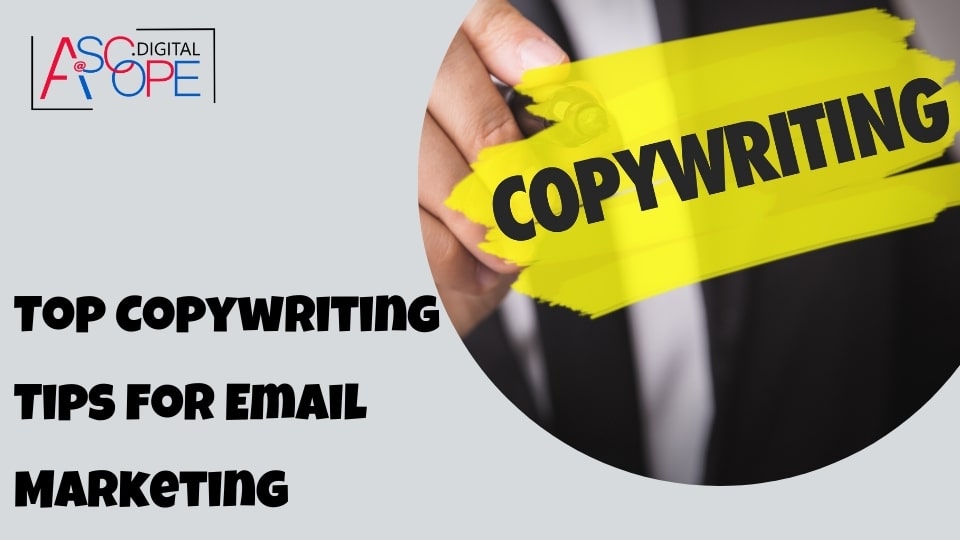In today’s digital age, email marketing stands as one of the most effective channels for businesses to communicate with their audience. However, the success of email campaigns hinges on the quality of the copywriting. Crafting compelling, engaging, and persuasive content can be the difference between your emails being opened and acted upon or ending up in the trash folder. In this article, we will explore the top copywriting tips for email marketing to help you create emails that not only reach your audience but also resonate with them.
Understanding Your Audience
The foundation of effective copywriting begins with a deep understanding of your audience. Who are they? What are their interests, needs, and pain points? Conducting thorough research and creating detailed buyer personas can provide invaluable insights into what your audience values and how they communicate. This understanding allows you to tailor your message to their preferences, increasing the likelihood of engagement.
Crafting Compelling Subject Lines
The subject line is the first thing your audience sees, and it significantly impacts whether your email gets opened. A compelling subject line should be concise, intriguing, and relevant. It should spark curiosity or offer a clear benefit to the reader. Personalization can also boost open rates; using the recipient’s name or referencing their recent activity can make your email stand out in a crowded inbox.
Focusing on the Opening Line
Once your email is opened, the opening line must captivate the reader’s attention. This is your opportunity to make a strong first impression. A good opening line can be a question, a bold statement, or a compelling fact that immediately hooks the reader and entices them to continue reading. The goal is to create an immediate connection and set the tone for the rest of the email.
Keeping It Concise and Clear
In email marketing, brevity is your friend. Your audience is likely inundated with emails daily, so keeping your message concise and to the point is crucial. Avoid long-winded paragraphs and get straight to the core of your message. Use short sentences and paragraphs to make your email easy to scan, and ensure that your main points are clearly highlighted.
Writing for Readability
Readability is key to effective email copywriting. Use simple, everyday language that your audience can easily understand. Avoid jargon, technical terms, or overly complex sentences. Utilizing bullet points, subheadings, and white space can also improve readability, making it easier for your readers to digest the information quickly.
Emphasizing Benefits Over Features
When promoting a product or service, it’s essential to highlight the benefits rather than just listing features. Benefits answer the reader’s question, “What’s in it for me?” They show how your product or service can solve their problems or improve their lives. By focusing on benefits, you create a more compelling and persuasive message that resonates with your audience’s needs and desires.
Creating a Sense of Urgency
Incorporating a sense of urgency can motivate your audience to take immediate action. Phrases like “limited time offer,” “act now,” or “only a few left” can create a fear of missing out (FOMO), prompting readers to engage with your email promptly. However, be sure to use urgency ethically and sparingly to maintain trust and credibility with your audience.
Including a Clear Call-to-Action (CTA)
Every email should have a clear and compelling call-to-action (CTA). Your CTA tells the reader exactly what you want them to do next, whether it’s clicking a link, downloading a resource, or making a purchase. Make your CTA stand out by using action-oriented language and visually distinct buttons or links. Additionally, ensure that your CTA is aligned with the overall goal of your email campaign.
Personalizing Your Content
Personalization goes beyond just using the recipient’s name. Tailor your content to the individual’s preferences, behaviors, and past interactions with your brand. Segmenting your email list based on different criteria allows you to send more relevant and targeted messages. Personalized content can significantly improve engagement rates and foster a stronger connection with your audience.
Testing and Analyzing Your Emails

Effective email copywriting is an ongoing process that involves constant testing and optimization. A/B testing different elements of your emails, such as subject lines, CTAs, and content, can provide valuable insights into what resonates best with your audience. Analyzing key metrics like open rates, click-through rates, and conversion rates helps you refine your approach and continually improve your email marketing strategy.
Utilizing Social Proof
Social proof, such as testimonials, reviews, or case studies, can enhance the credibility and persuasiveness of your emails. Including positive feedback from satisfied customers or showcasing successful case studies can build trust and reassure your audience that your product or service delivers on its promises. Social proof adds an element of authenticity that can significantly impact decision-making.
Leveraging Storytelling
Storytelling is a powerful tool in copywriting that can make your emails more engaging and memorable. By weaving a compelling narrative, you can connect with your audience on an emotional level and make your message more relatable. Stories can illustrate the benefits of your product or service in a real-world context, making it easier for readers to envision themselves benefiting from it.
Using Power Words
Power words are persuasive and emotionally charged words that can evoke strong reactions from your audience. Words like “exclusive,” “proven,” “guaranteed,” and “effortless” can add impact to your email copy and drive engagement. However, it’s important to use power words judiciously and ensure they align with your brand voice and message.
Maintaining Consistent Tone and Voice
Consistency in tone and voice helps build a recognizable and trustworthy brand. Your email copy should reflect your brand’s personality and values. Whether your tone is casual and friendly or formal and professional, maintaining consistency across all your email communications fosters a sense of familiarity and reliability with your audience.
Avoiding Spam Triggers
To ensure your emails reach the inbox rather than the spam folder, it’s crucial to avoid common spam triggers. These include excessive use of exclamation marks, all caps, and certain spammy phrases like “free” or “buy now.” Additionally, make sure your email content is relevant and valuable to the recipient, as engagement metrics play a significant role in spam filtering algorithms.
Enhancing Mobile Responsiveness
With a significant portion of emails being opened on mobile devices, it’s essential to ensure your emails are mobile-friendly. Use responsive design techniques to optimize your email layout for different screen sizes. Keep your copy concise, use larger fonts for readability, and ensure that your CTAs are easily clickable on mobile devices.
Incorporating Visual Elements
While the focus is on copywriting, incorporating visual elements can enhance the overall impact of your emails. Images, videos, and infographics can break up text and make your email more visually appealing. However, use visuals sparingly and ensure they complement and enhance your message rather than distract from it.
Engaging with Interactive Content
Interactive content, such as polls, quizzes, and surveys, can boost engagement and make your emails more interactive and enjoyable. Including interactive elements encourages readers to actively participate and can provide valuable insights into their preferences and behaviors. Just ensure that the interactive content is relevant and adds value to the overall email experience.
Providing Value with Educational Content
Educational content positions your brand as an authority and provides value to your audience. Sharing tips, how-to guides, industry insights, or exclusive resources can help build trust and credibility. When your emails consistently offer valuable information, your audience is more likely to engage with them and view your brand as a reliable source of knowledge.
Ensuring Accessibility
Accessibility is an important consideration in email copywriting. Ensure that your emails are easily readable and navigable for all recipients, including those with disabilities. Use alt text for images, maintain a clear structure with headings and lists, and choose a legible font size and color contrast. Prioritizing accessibility ensures that your message reaches a broader audience.
Building Anticipation
Creating anticipation for upcoming events, product launches, or special offers can generate excitement and engagement. Tease your audience with sneak peeks, countdowns, or exclusive previews to build anticipation. This approach keeps your audience eagerly awaiting your emails and increases the likelihood of immediate action when the time comes.
Keeping It Conversational
Writing in a conversational tone makes your emails feel more personal and relatable. Imagine you’re writing to a friend rather than a large audience. Use informal language, ask questions, and encourage a two-way conversation. A conversational tone can create a stronger connection with your readers and make your emails more enjoyable to read.
Avoiding Overwhelming Your Audience
While providing valuable information is important, be mindful not to overwhelm your audience with too much content in a single email. Focus on one main message or goal per email and keep it concise. If you have multiple points to cover, consider breaking them into a series of emails. This approach ensures your audience can easily absorb and act on your message.
Building Trust with Transparency

Transparency builds trust and credibility with your audience. Be honest and upfront in your emails, whether you’re addressing product limitations, pricing, or any other relevant information. Transparency fosters a sense of integrity and reliability, which can strengthen your relationship with your audience and encourage long-term loyalty.
Using Humor Wisely
Humor can be a powerful tool in email copywriting, but it should be used wisely and appropriately. A well-placed joke or witty remark can make your emails more engaging and memorable. However, be mindful of your audience’s preferences and cultural sensitivities to ensure your humor is well-received and doesn’t inadvertently offend.
Encouraging Feedback and Interaction
Encourage your audience to provide feedback and interact with your emails. Include options for readers to reply with their thoughts, take surveys, or share their experiences. Engaging with your audience fosters a sense of community and provides valuable insights that can help you improve your email marketing strategy.
Celebrating Milestones and Achievements
Acknowledging and celebrating milestones, both for your brand and your audience, can create a positive and engaging email experience. Whether it’s an anniversary, a major achievement, or a subscriber milestone, sharing these moments with your audience builds a sense of connection and appreciation.
Offering Exclusive Content
Exclusive content, such as early access to new products, special discounts, or members-only resources, can make your audience feel valued and appreciated. Exclusivity creates a sense of privilege and can drive engagement and loyalty. Ensure that the exclusive content is genuinely valuable and aligns with your audience’s interests and needs.
Balancing Promotion and Value
While the ultimate goal of email marketing is often to drive sales or conversions, it’s essential to balance promotional content with value-driven content. Constantly bombarding your audience with sales pitches can lead to disengagement and unsubscribes. Strive to provide valuable, informative, and entertaining content alongside your promotional messages to maintain a healthy engagement rate.
Staying Updated with Trends
The world of email marketing is constantly evolving, with new trends and best practices emerging regularly. Staying updated with the latest trends, tools, and techniques can give you a competitive edge and help you refine your email copywriting strategy. Subscribe to industry newsletters, attend webinars, and participate in online communities to stay informed and inspired.
Reviewing and Editing

Finally, never underestimate the power of thorough review and editing. Typos, grammatical errors, and unclear messaging can undermine your credibility and distract from your message. Take the time to review and edit your emails carefully before hitting send. Consider using tools like grammar checkers and readability analyzers to ensure your copy is polished and professional.
Crafting Engaging Calls-to-Action
A compelling call-to-action (CTA) is crucial in driving the desired response from your email recipients. It serves as a clear directive that guides them on what to do next, whether it’s making a purchase, signing up for a webinar, or downloading a resource. Your CTA should be concise, action-oriented, and create a sense of urgency. Personalizing your CTAs can also significantly boost engagement, as it makes the recipient feel that the offer is tailored specifically for them. Additionally, strategically placing your CTA within the email ensures it catches the reader’s attention at the right moment. Effective CTAs not only encourage immediate action but also enhance the overall user experience. Thus, improving traffic and sales for your website. Read more on the other reasons why your website isn’t getting traffic. By focusing on crafting strong CTAs, you can convert readers into loyal customers and maximize the impact of your email marketing campaigns.
Conclusion
Mastering the art of email copywriting requires a combination of creativity, strategy, and continuous improvement. By understanding your audience, crafting compelling subject lines, focusing on readability, and emphasizing benefits, you can create emails that engage and persuade. Remember to personalize your content, test and analyze your emails, and stay updated with the latest trends to keep your email marketing strategy effective and relevant. With these top copywriting tips, you’re well-equipped to elevate your email marketing campaigns and achieve greater success.


